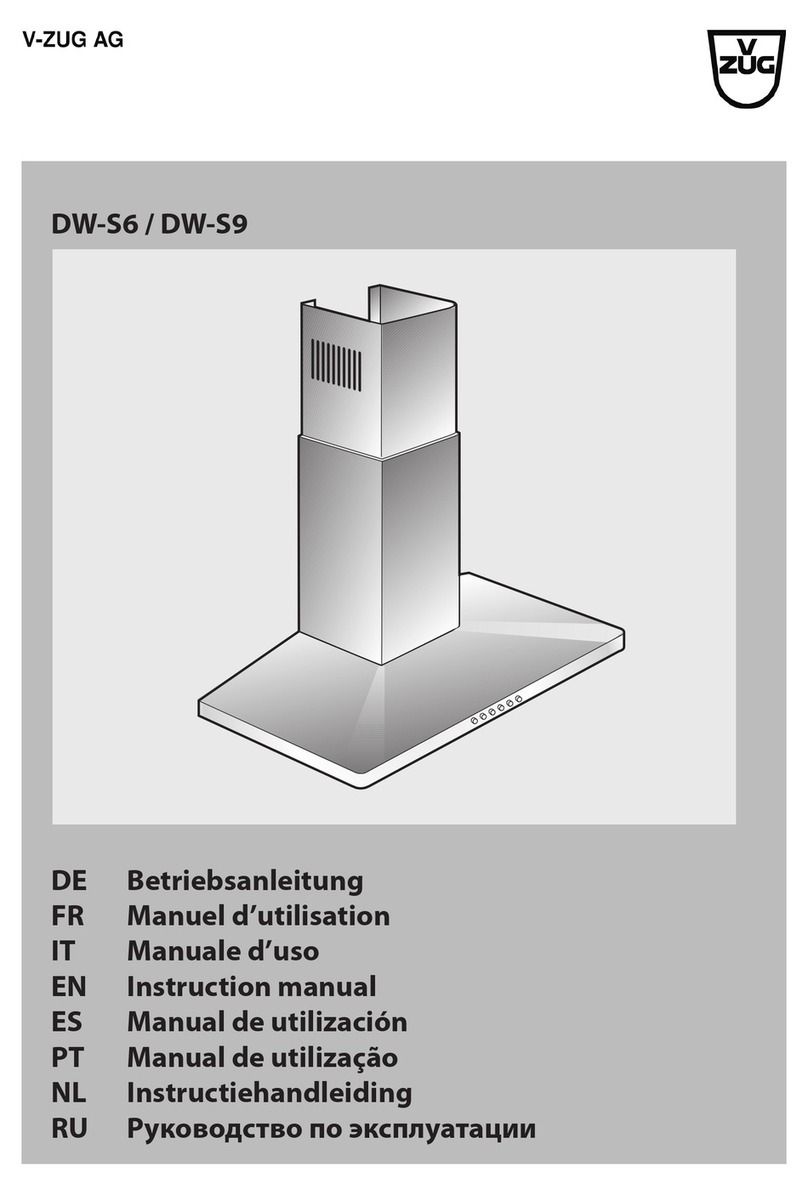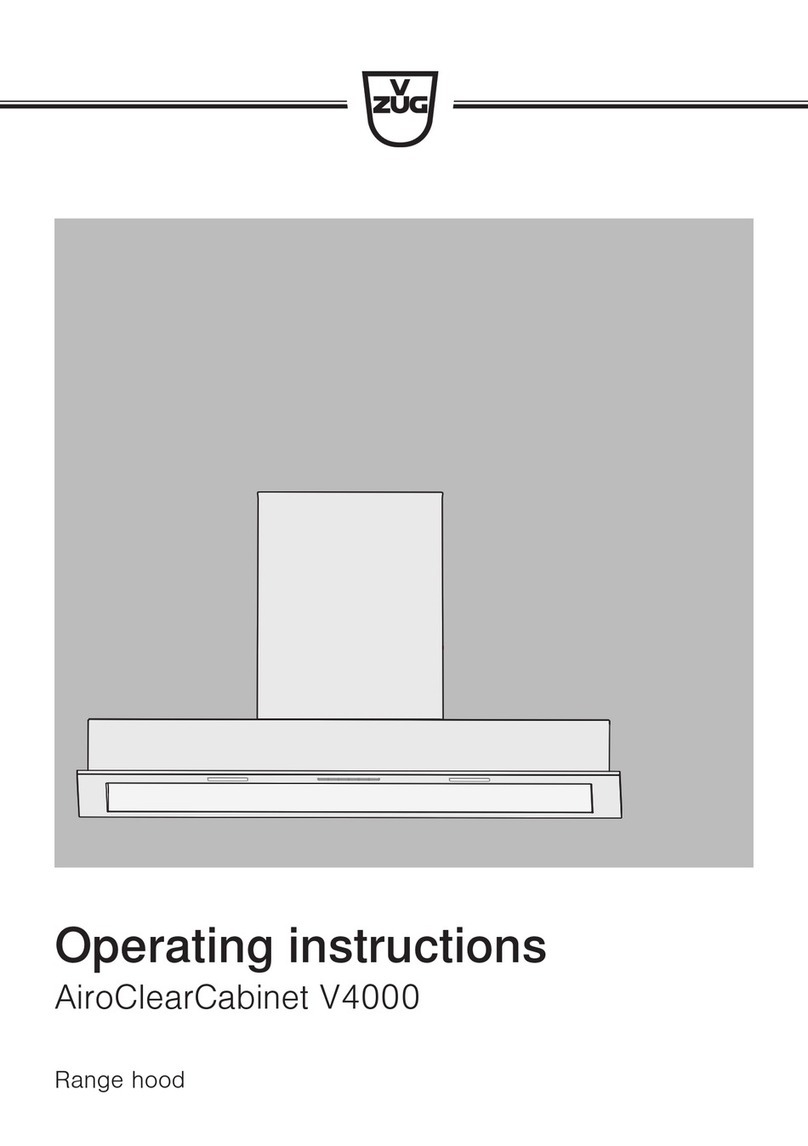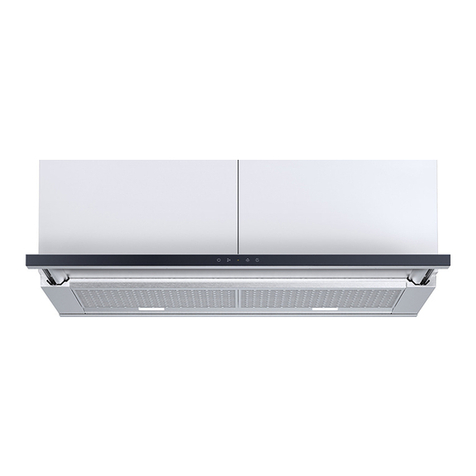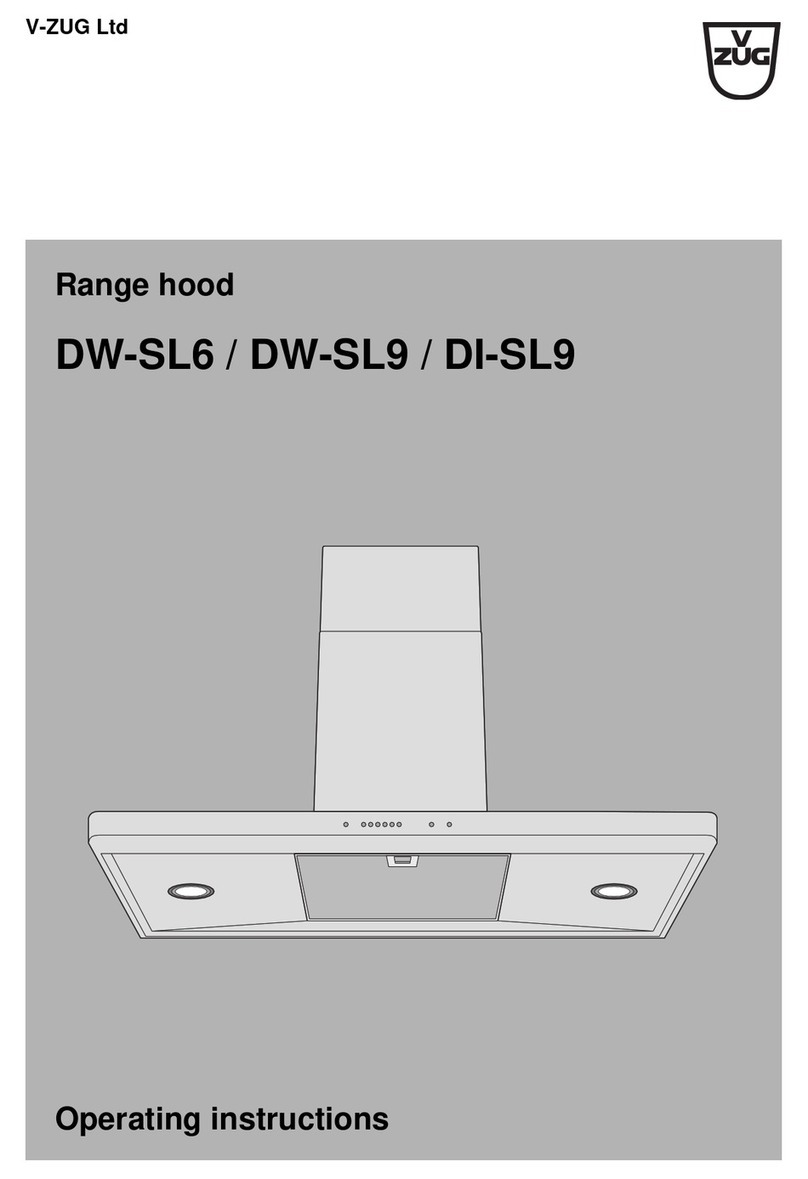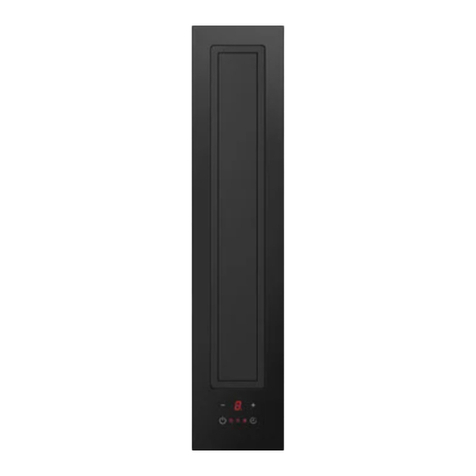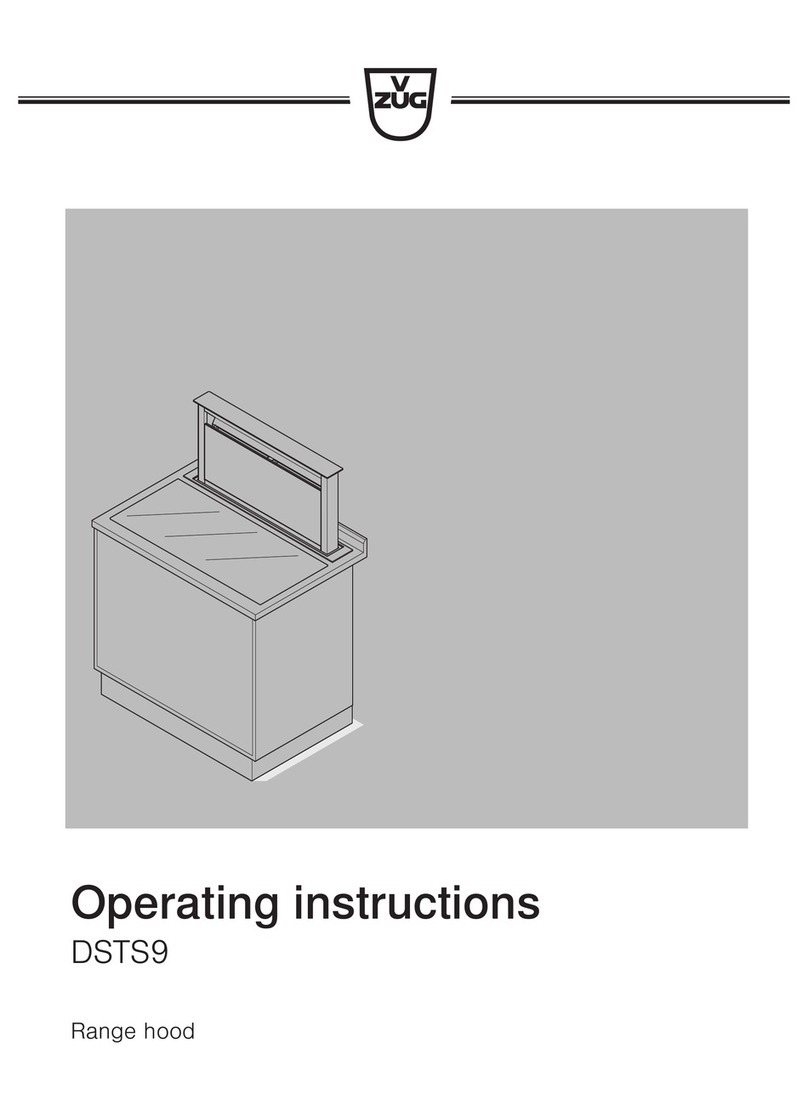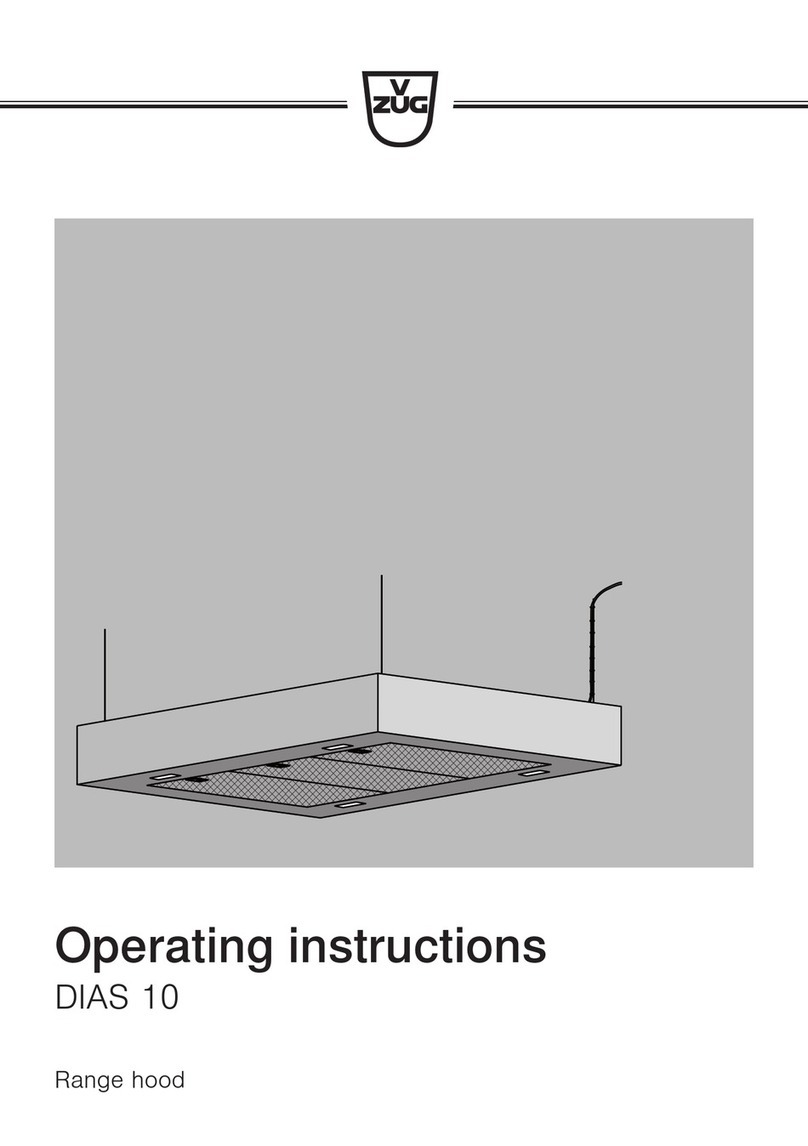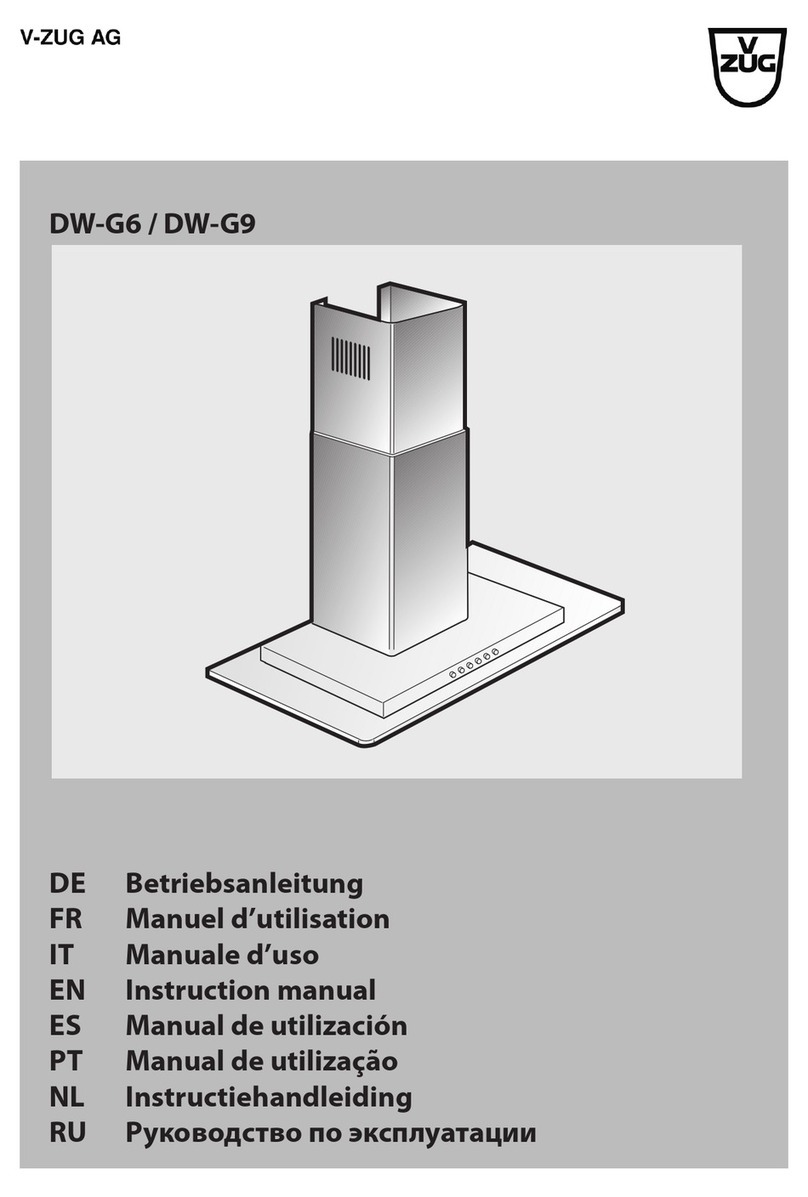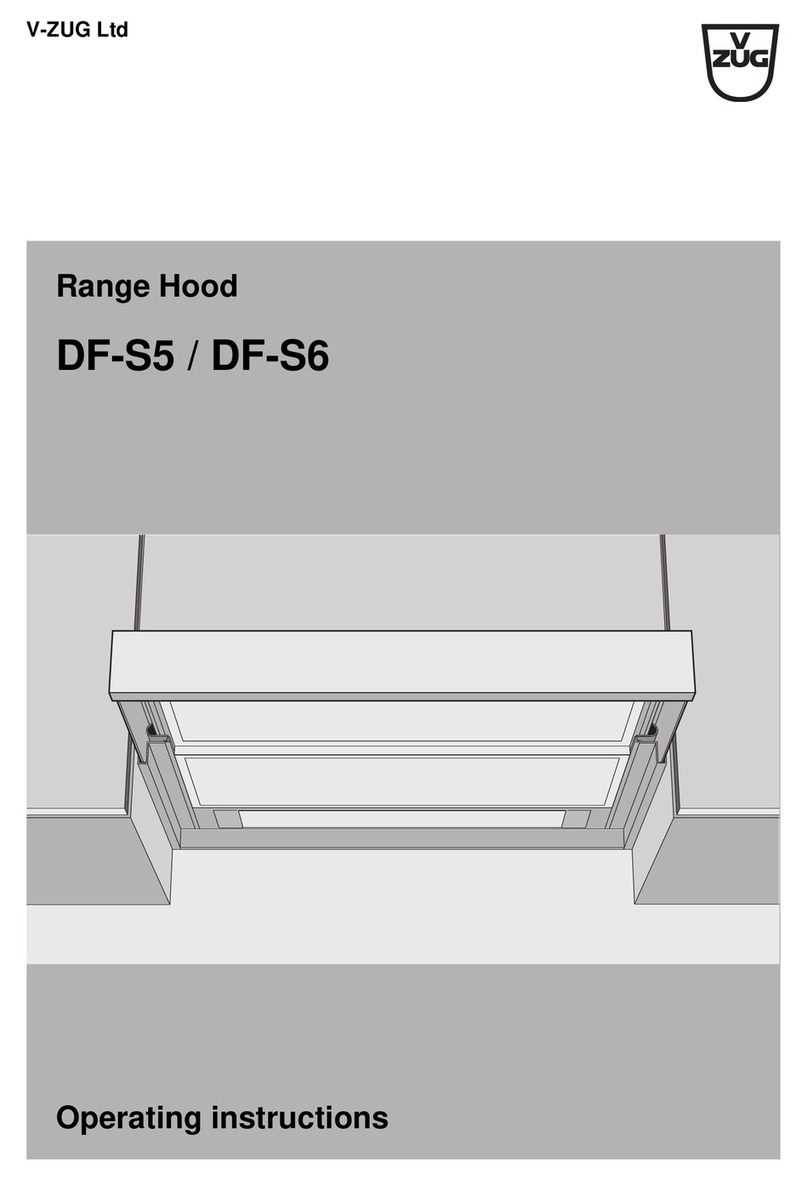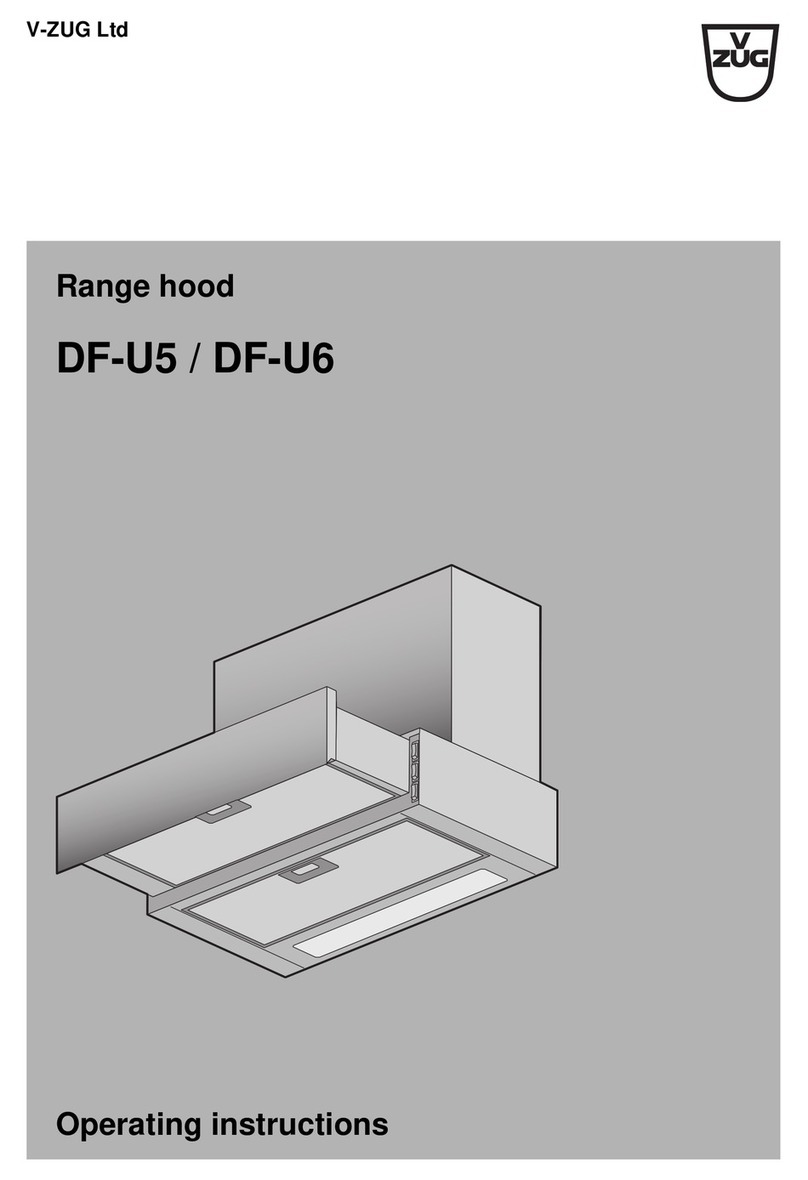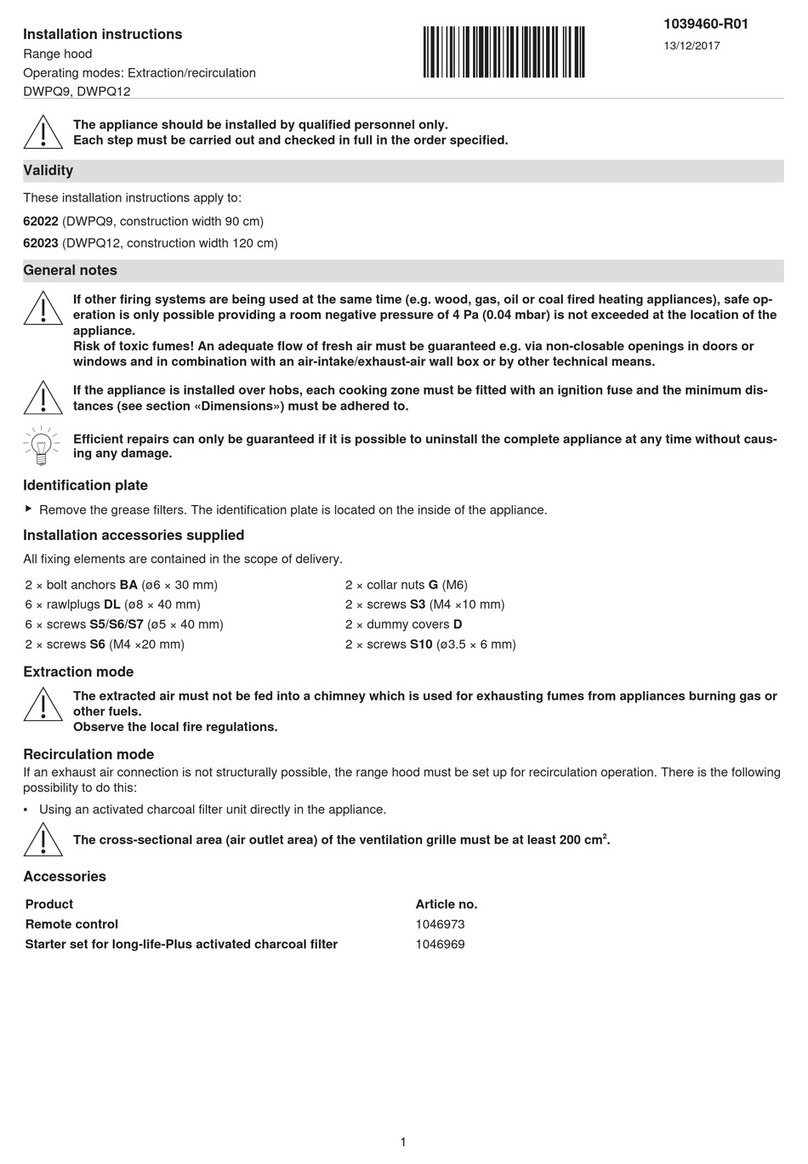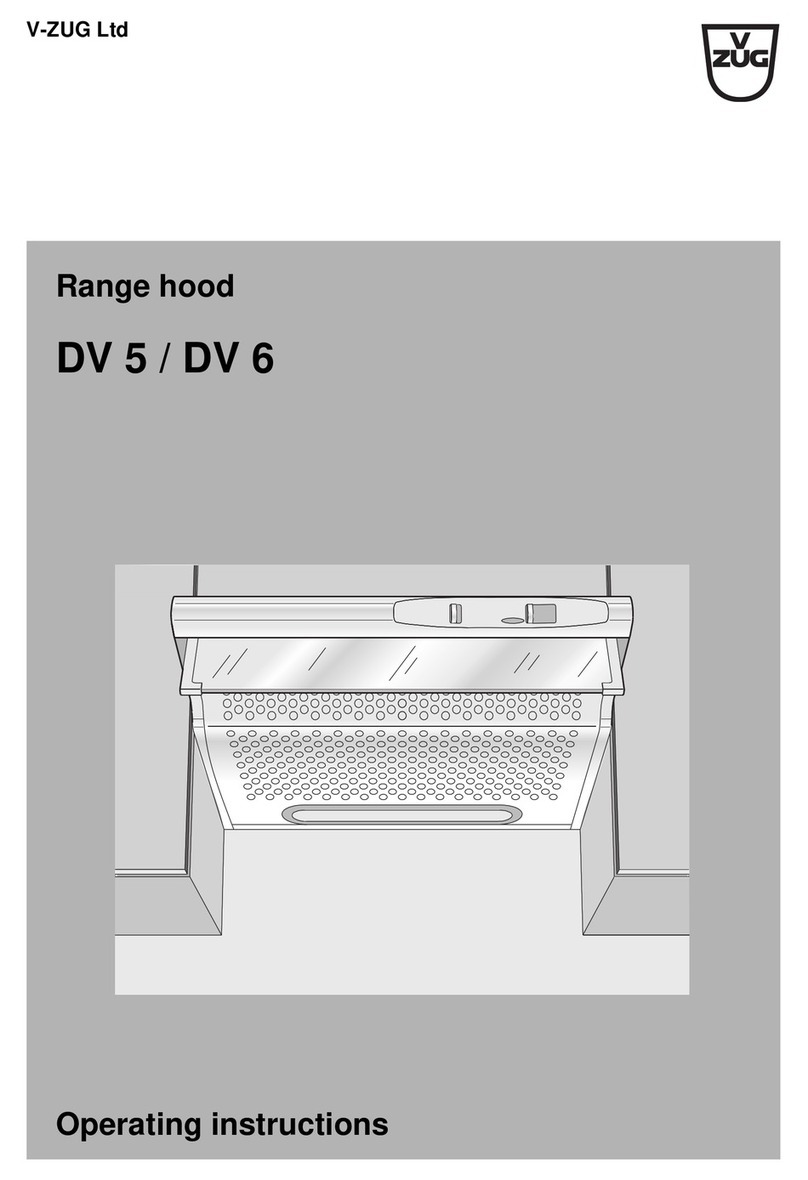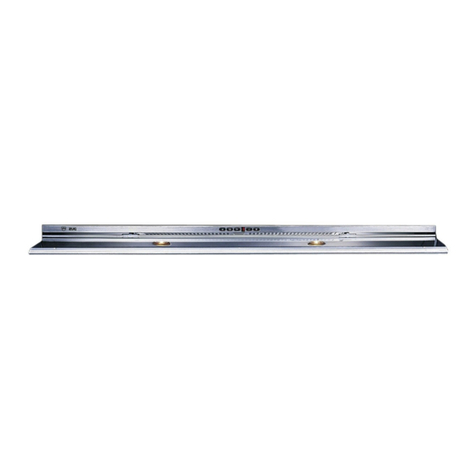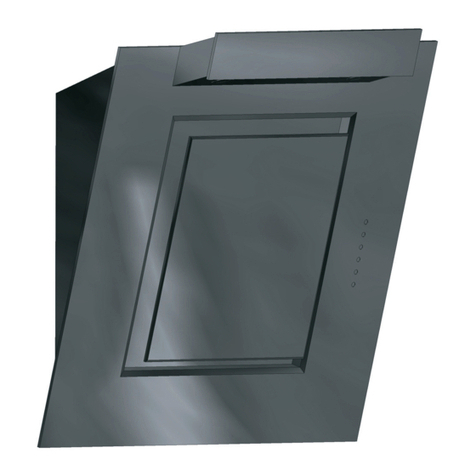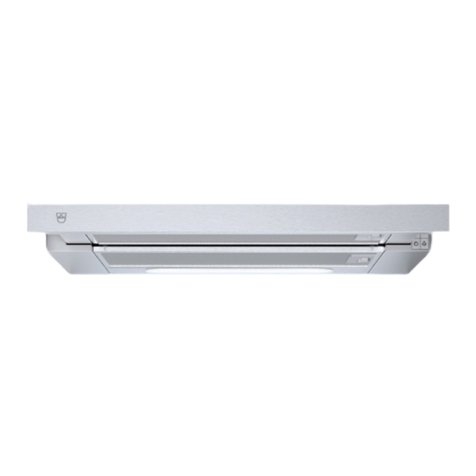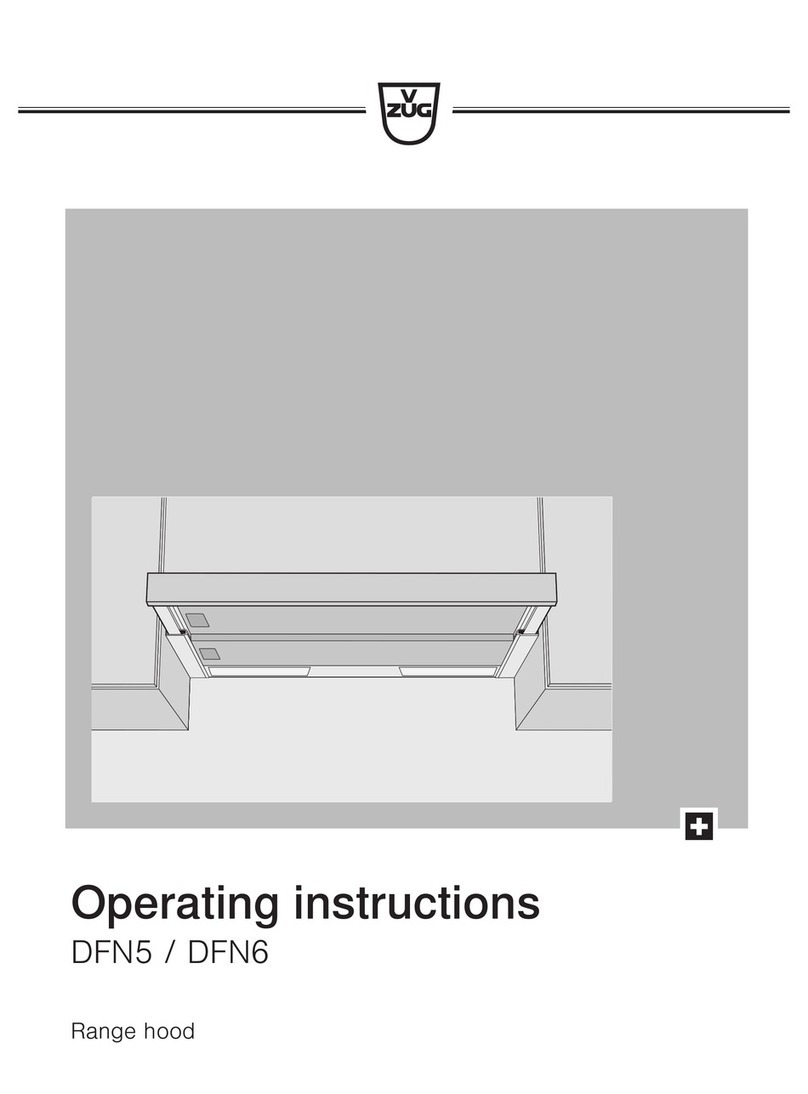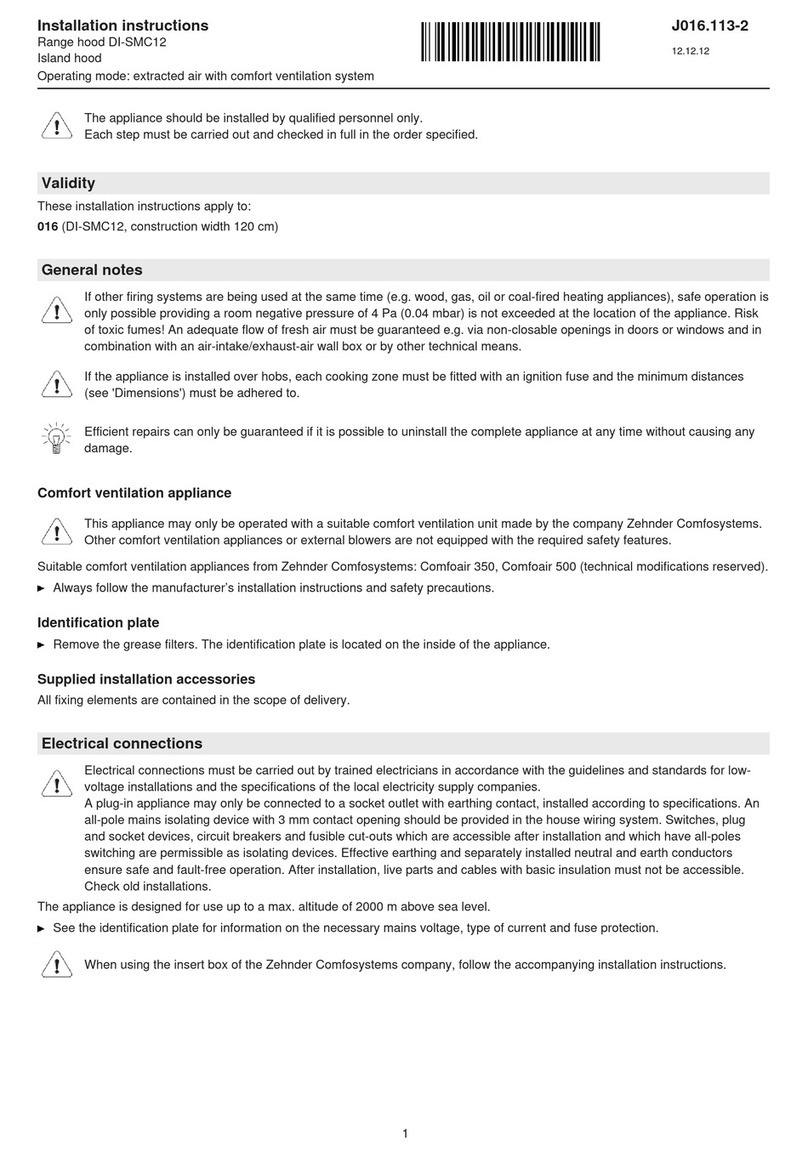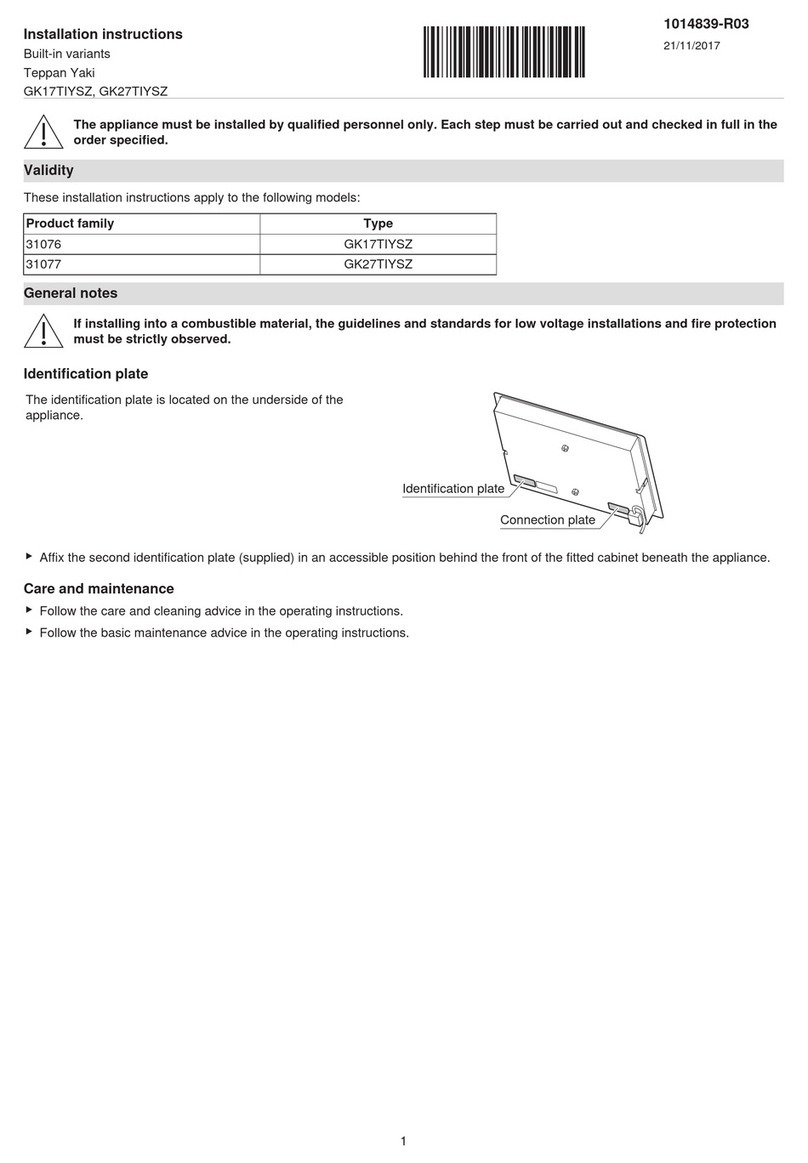bereiten Sie eine Luftabzugsönung vor.
-Die Unterseite der Dunstabzugshaube an der Wand vor-
zeichnen, Abb.3A (dabei den Mindestabstand zur Kochäche
berücksichtigen).
-Die Bohrschablone an der Wand anbringen; dabei darauf
achten, dass die Linie mit der vorgezeichneten des vorherigen
Absatzes übereinstimmt.
-Die Befestigungsbohrungen markieren und ausführen
(Abb.3B).
-Die 7 Spreizdübel sowie die 6 Schrauben Cbefestigen, ohne
diese vollständig anzuziehen (Abb.3B).
-Das Gerät an der Wand anbringen (Abb.4).
-Darauf achten, dass die 2 Nivellierschrauben Jvollständig
angezogen sind (Abb.5).
-Das Gerät in waagerechter Position durch Betätigung der
beiden Nivellierschrauben Jausrichten (Abb.5).
-Nach erfolgter Einstellung die Dunstabzugshaube mit den
Schrauben Cund Dendgültig befestigen (Abb.4).
-Damit das Motoraggregat bei einemWartungseingri leicht
zu erreichen ist empehlt es sich, nach der endgültigen Nivel-
lierung und Befestigung des Geräts die Bügel abzunehmen
(Abb.5).
-Verwenden Sie zur Geräteinstallation Schrauben und Dübel,
die für die jeweilige Wandart geeignet sind (zum Beispiel:
Betonwände, Wände aus Gipspappe usw.).
-Sollten die Schrauben und Dübel als Geräteausstattung
mitgeliefert werden, stellen Sie bitte sicher, dass diese für die
Art der Wand, an die das Gerät montiert werden soll, geeignet
sind.
-Die Stromzuleitung innerhalb des Raumbedarfs derTeleskop-
verschalung verlegen. Falls Ihr Gerät in Abluftversion oder
Version mit äußerem Motor zu installieren ist, das Luftaus-
trittsloch vorbereiten.
-Die Breite des Haltebügels anhand der oberen Teleskopver-
schalung einstellen (Abb.7).
-Dann mit den Schrauben A(Abb.7) so an der Decke befesti-
gen, daß er mit der Abzugshaube ausgerichtet ist und die in
Abb.6 angegebene Entfernung von der Decke einhalten.
-Mittels eines Abluftrohrs den Flansch Fmit dem Luftaustritts-
loch verbinden (Abb.8).
-Die obere Teleskopverschalung in die untere Teleskopver-
schalung stecken.
-Die untere Teleskopverschalung auf der Haube in Position
bringen und die obere Teleskopverschalung bis zum Bügel
ausziehen und mit den Schrauben B(Abb.9) befestigen.
-Zur Umrüstung der Abzugshaube von der Abluftversion in
die Umluftversion, beim Händler die Aktivkohlelter besorgen
und die Montageanleitung befolgen.
-Achtung: Die Dunstabzugshaube kann auch mit dem
Luftabzug nach hinten installiert werden. Herzu wird das
Blech X mit dem Motor abgenommen und sie wird wie in
Abb.10 gezeigt gedreht.
Nehmen Sie auch den Wandbefestigungsbügel Y ab und
positionieren Sie ihn unter Verwendung der gleichen
Schrauben wie in Abb.10 gezeigt.
Mittels eines Abluftrohrs den Flansch Fmit dem vorbereiteten
Luftaustrittsloch verbinden. Für einen sauberen Abschluss
kann die Abdeckung Mmontiert werden (Abb.11).
Version:
-Das Gitter Eund den Kabeldurchgang Hvon der Abdeckung
Mlösen (Abb.12A - Abb.12B).
-Das Stromkabel durch den Schlitz in der Abdeckung M wie
in Abb.12B gezeigt führen.
-Nehmen Sie den Kabeldurchgang Hund setzen Sie ihn
zwischen das Versorgungskabel und den Schlitz.
-Setzen Sie die Aktivkohlelter in das Gerät ein (Abb.13).
-Die Abdeckung Mbefestigen und darauf achten, dass sie
richtig in die Befestigungsstifte eingehakt wird (Abb.11).
BENUTZUNG UND WARTUNG
Es wird empfohlen, die Dunstabzugshaube schon vor
Kochbeginn der Speisen einzuschalten. Es wird weiterhin
empfohlen, das Gerät nach Beendigung des Kochvorgangs
noch 15 Minuten weiterlaufen zu lassen, um den vollständigen
Abzug der Kochdünste zu gewährleisten.
Die Leistungsfähigkeit der Dunstabzugshaube hängt
entscheidend von der Sorgfalt und Regelmäßigkeit der
Wartung ab, insbesondere die des Fettlters und die des
Aktivkohlelters.
hat die Aufgabe, die in den Kochdünsten
enthaltenen Fettpartikel zurückzuhalten. Er ist demnach der
Verschmutzung besonders ausgesetzt und sollte, je nach
Gebrauch und Kochgewohnheiten, in mehr oder weniger
langen Zeitabschnitten gereinigt werden.
- Um der Brandgefahr vorzubeugen, müssen maximal alle 2
Monate die Fettlter gewaschen werden. Das geht auch mit
der Spülmaschine.
- Nach einigen Waschgängen können Farbveränderungen
auftreten. Hieraus resultiert jedoch kein Anspruch auf kosten-
losen Ersatz derselben.
Durch Nichteinhaltung der Vorgaben hinsichtlich des
Austauschs und der Reinigung der Fettfilter kann Brand
verursacht werden.
dienen dazu, die Luft, die in den Raum
zurückgeleitet wird zu reinigen; sie haben die Aufgabe, die
unangenehmen Gerüche, die während des Garvorgangs
entstehen, zu beseitigen.
- Die Standard-Aktivkohlelter müssen mindestens alle 4
Monate ausgewechselt werden. Die Sättigung der Aktivkohle
hängt davon ab, wie oft das Gerät benutzt wird, vom Gartyp
und von der Häugkeit, mit der die Reinigung des Fettlters
durchgeführt wird.
- Die Longlife-Aktivkohlelter müssen per Hand mit neutralen,
nicht scheuernden Reinigungsmitteln gewaschen werden
oder man gibt ihn in die Spülmaschine bei einer Temperatur,
die 65°C nicht überschreiten darf (der Waschzyklus muss
ohne Geschirr vollendet werden). Das überschüssige Wasser
entfernen ohne den Filter dabei zu beschädigen, die Bauteile
aus Kunststo entfernen und das Vlies im Ofen 60 Minuten
lang bei einer Temperatur von max. 100°C trocknen. Bei
normaler Nutzung des Gerätes sollte der Longlife-Filter jeden
Monat, oder wenn die Taste A blinkt, gereinigt werden. Nach
etwa 3 Jahren muss der Longlife-Filter ersetzt werden, da die
Geruchsfähigkeit reduziert wird.
Aktivkohlelters ist es unbedingt nötig sicherzustellen,
dass diese gut getrocknet sind.
Reinigen Sie die Haube innen und außen regelmäßig mit
Spiritus oder einem neutralen Flüssigreiniger ohne Scheuer-
mittel.
Die Beleuchtung der Dunstabzugshaube ist dazu geplant,
während des Kochvorgangs eingesetzt zu werden. Durch
einen verlängerten Einsatz der Beleuchtung wird die durch-
schnittliche Lebensdauer der Leuchten erheblich gemindert.
Das Nichteinhalten dieser Hinweise für die Reini-
gung der Haube und deren Auswechseln und die Reinigung
der Filter, führen zu Brandgefahr. Es wird daher empfohlen,
die hier gegebenen Ratschläge zu befolgen.
- 10 -
